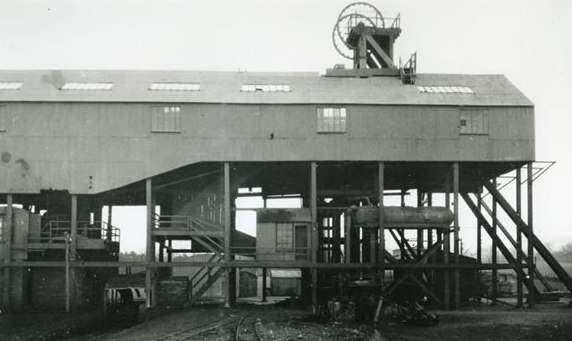
Breich Nos 1 & 2 Pits
Copyright © Almond Valley Heritage Trust
and licensed for reuse under this Creative Commons Licence
Oil-shales were predominantly formed in aquatic environments, either seas or lakes, and occur world wide. They are carbonaceous, fine-grained sedimentary rocks, rich in organic matter, which produce shale oil when heated in retorts. Historically they were burnt in domestic fires, like coal, but in the late nineteenth century they were distilled to produce oil and other chemicals. Some oil-shales occur in Jurassic rocks on England’s southern coast, but the principal workings were in Scotland, where they occur in the Strathclyde Group of strata, which formed in the Visean epoch (326-345 Mya) of the Carboniferous period. Most are in West Lothian and adjoining parts of South Lanarkshire, but even then, the oil-shales are not of a consistently workable thickness and were best developed around Livingston. There are also isolated deposits in Midlothian and Fife, while more recent oil-shales are often associated with coals.
Oil-shale is almost indistinguishable from most other mudstones or shales, but scraping with a knife produces a chocolaty brown streak. Even in producing areas the oil content of the shale varies depending on what part of the bed was taken. The cost of mining and refining had, therefore, to be constantly weighed against the value of the oil produced.
In 1848 Dr James Young (1811-1883) began refining oil that seeped naturally into a colliery at Alfreton in Derbyshire. He also experimented on extracting oil from cannel coal and, in 1850, he had a share in a patent for the resulting process. The Derbyshire oil soon ran out, however, and Young found an alternative supply of suitable cannel coal at Boghead Colliery (NS971680) at Bathgate in Linlithgowshire, Scotland. By 1851 Young had set up the world’s first oil refinery producing crude oil, paraffin oil, paraffin wax, naptha, gas, coke, and ammonium sulphate fertiliser, all products which were in high demand and which returned high profits. By the time that this coal was exhausted, Young had discovered the area’s oil shale which, although giving lower yields of oil than cannel coal, was cheap and easy to extract. Thus, in 1862, the oil-shale mining industry began. Large refineries were built, where the shale was heated in retorts to release the hydro-carbon content.
Most of the Scottish oil-shale mines closed between the wars, but a few survived until around 1962 when they too closed in the face of cheaper imported oil from Arabia. The industry’s legacy was a spread of large, burnt-shale heaps, or bings, which dominated the landscape. Many have since been quarried for use as road sub-base etc, but the national and local importance of a few (e.g. the ‘Five Sisters’, near West Calder, at NT00926407) has been recognised for their visual impact and bio-diversity.
Accidents in these mines were rare, but a methane explosion occurred at Burngrange Oil Shale Mine, West Calder in 1947. This was caused by gas that had collected gradually over a period of time in the waste where its presence could not normally be detected. Some of it had been expelled by roof movements or falls of the roof in the waste and was ignited by an open acetylene lamp. 15 died.
For anyone wishing to know more about the oil-shale industry, the website of the Museum of the Scottish Shale Oil Industry is highly recommended.
Return to previous page
